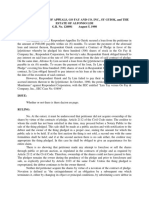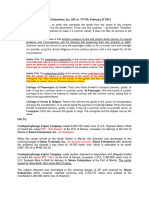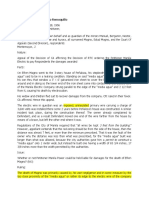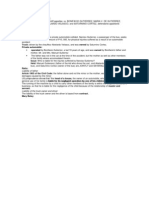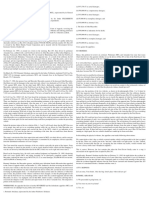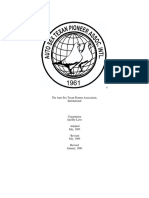Rogelio Nogales V. Capitol Medical Center
Rogelio Nogales V. Capitol Medical Center
Uploaded by
Al-husaynLaoSanguilaCopyright:
Available Formats
Rogelio Nogales V. Capitol Medical Center
Rogelio Nogales V. Capitol Medical Center
Uploaded by
Al-husaynLaoSanguilaOriginal Description:
Original Title
Copyright
Available Formats
Share this document
Did you find this document useful?
Is this content inappropriate?
Copyright:
Available Formats
Rogelio Nogales V. Capitol Medical Center
Rogelio Nogales V. Capitol Medical Center
Uploaded by
Al-husaynLaoSanguilaCopyright:
Available Formats
ROGELIO NOGALES V.
CAPITOL MEDICAL CENTER
G.R. No. 142625, 19 December 2006
Facts:
Pregnant with her fourth child, Corazon Nogales (Corazon), who
was then 37 years old, was under the exclusive prenatal care of Dr.
Oscar Estrada (Dr. Estrada) beginning on her fourth month of
pregnancy or as early as December 1975. Around midnight of 25 May
1976, Corazon started to experience mild labor pains prompting
Corazon and Rogelio Nogales (Spouses Nogales) to see Dr. Estrada at
his home. After examining Corazon, Dr. Estrada advised her
immediate admission to the Capitol Medical Center (CMC). t 6:13
a.m., Corazon started to experience convulsionsAt 6:22 a.m., Dr.
Estrada, assisted by Dr. Villaflor, applied low forceps to extract
Corazon's baby. In the process, a 1.0 x 2.5 cm. piece of cervical tissue
was allegedly torn.At 6:27 a.m., Corazon began to manifest moderate
vaginal bleeding which rapidly became profuse. Corazon died at 9:15
a.m. The cause of death was uhemorrhage, post partum.
Issue:
Whether or not CMC is vicariously liable for the negligence of Dr.
Estrada.
Ruling:
Private hospitals, hire, fire and exercise real control over their
attending and visiting uconsultantu staff. The basis for holding an
employer solidarily responsible for the negligence of its employee is
found in Article 2180 of the Civil Code which considers a person
accountable not only for his own acts but also for those of others
based on the former's responsibility under a relationship of patria
potestas.
In general, a hospital is not liable for the negligence of an
independent contractor-physician. There is, however, an exception to
this principle. The hospital may be liable if the physician is the
uostensibleu agent of the hospital. This exception is also known as the
udoctrine of apparent authorityu.
For a hospital to be liable under the doctrine of apparent
authority, a plaintiff must show that:
1. the hospital, or its agent, acted in a manner that would lead a
reasonable person to conclude that the individual who was alleged to
be negligent was an employee or agent of the hospital;
2. where the acts of the agent create the appearance of
authority, the plaintiff must also prove that the hospital had
knowledge of and acquiesced in them; and
3. the plaintiff acted in reliance upon the conduct of the hospital
or its agent, consistent with ordinary care and prudence. In the
instant case, CMC impliedly held out Dr. Estrada as a member of its
medical staff. Through CMC's acts, CMC clothed Dr. Estrada with
apparent authority thereby leading the Spouses Nogales to believe
that Dr. Estrada was an employee or agent of CMC.
FILCAR TRANSPORT SERVICES V. ESPINAS
GR. No. 174156, 20 June 2012
Facts:
Espinas, while driving, was hit by another car. The other car
escaped from the scene of the incident, but Espinas was able to get its
plate number.
After verifying with the Land Transportation Office, Espinas
learned that the owner of the other car, with plate number UCF-545 is
Filcar.
After sending several letters to Filcar and to its President and
General Manager Carmen Flor,demanding payment for the damages
sustained by his car without response, Espinas filed a complaint for
damages against Filcar and Carmen Flor demanding the amount of
P97,910.00, representing actual damages sustained by his car. Filcar
argued that while it is the registered owner of the car that hit and
bumped Espinas car, the car was assigned to its Corporate Secretary
Atty. Candido Flor, the husband of Carmen Flor. Filcar furtherstated
that when the incident happened, the car was being driven by Atty.
Flors personal driver,Timoteo Floresca.Filcar denied any liability to
Espinas and claimed that the incident was not due to its fault or
negligence since Floresca was not its employee but that of Atty. Flor.
Filcar and Carmen Flor.
Issue:
Whether Filcar, as registered owner of the motor vehicle which
figured in an accident, may be held liable for the damages caused to
Espinas.
Ruling:
Yes. Filcar, as registered owner, is deemed the employer of the
driver, Floresca, and is thus vicariouslyliable under Article 2-3 in
relation with Article 24/ ofthe Civil Code As a general rule, one is
only responsible for his own act or omission.Thus, a person will
generally beheld liable only for the torts committed by himselfand not
by another. The law, however, provides fore5ceptions that an employer
is made vicariously liable for the tort committed by his employee.
Article24/ ofthe Civil Code states6Article 24/. The obligation
imposed by Article 2-3 is demandable not only for one0s own acts
oromissions, but also for those ofpersons for whom one is responsible.
Employers shall be liable for the damages caused by their employees
and household helpers actingwithin the scope oftheir assigned tas7s,
even though the former are not engaged in any business orindustry.
Under Article 2176, in relation with Article 2180, ofthe Civil
Code, an action predicated on an employees act or omission may be
instituted against the employer who is held liable for the negligentact
or omission committed by his employee.It is well settled that in case
ofmotor vehicle mishaps, the registered owner ofthe motor vehicle
isconsidered as the employer ofthe tortfeasor'driver, and is made
primarily liable for the tort committedby the latter under Article 2176,
in relation with Article 2180, ofthe Civil Code.Filcar is not be
permitted to evade its liability for damages by conveniently passing on
the blame toanother party8 in this case, its Corporate Secretary, Atty.
Flor and his alleged driver, Floresca. WHEREFORE, the petition is
DENIED. The decision the Court of Appeals are AFFIRMED.
Costsagainst petitioner Filcar Transport Services.
You might also like
- Deed of Assignment SampleDocument2 pagesDeed of Assignment SampleAl-husaynLaoSanguila91% (23)
- Contract of Sale of Real Property SampleDocument3 pagesContract of Sale of Real Property SampleAl-husaynLaoSanguila57% (7)
- All Wars Are Bankers WarsDocument27 pagesAll Wars Are Bankers Warsgyrfalcon100% (2)
- Memorandum of Agreement Sample Land TitlesDocument2 pagesMemorandum of Agreement Sample Land TitlesAl-husaynLaoSanguila33% (3)
- Scanned With CamscannerDocument8 pagesScanned With CamscannerAl-husaynLaoSanguilaNo ratings yet
- Heneral Luna PlotDocument1 pageHeneral Luna PlotAl-husaynLaoSanguila86% (14)
- Justification LetterDocument3 pagesJustification LetterAl-husaynLaoSanguilaNo ratings yet
- Key Concepts and Ideas of Filipino Thinkers in The Social Sciences Rooted in Filipino Languages and ExperiencesDocument46 pagesKey Concepts and Ideas of Filipino Thinkers in The Social Sciences Rooted in Filipino Languages and ExperiencesRochelle Dulay De Guzman93% (15)
- Democratic Education - What Would Dewey SayDocument8 pagesDemocratic Education - What Would Dewey SaySebastian BedoyaNo ratings yet
- Black Radicalism SyllabusDocument3 pagesBlack Radicalism SyllabusPaul Handyman0% (1)
- 61 Republic V GalloDocument1 page61 Republic V GalloJoshua Alexander CalaguasNo ratings yet
- State Investment v. CADocument1 pageState Investment v. CAJm EjeNo ratings yet
- Conclusively: Vicarious Liability or Imputed LiabilityDocument34 pagesConclusively: Vicarious Liability or Imputed LiabilityElica DiazNo ratings yet
- 12 Lambert v. Heirs of CastillonDocument13 pages12 Lambert v. Heirs of CastillonBerNo ratings yet
- FEBTC v. Pacilan Digest: Callejo SR, J.Document9 pagesFEBTC v. Pacilan Digest: Callejo SR, J.Arcide Rcd ReynilNo ratings yet
- Summary Data Privacy ActDocument5 pagesSummary Data Privacy ActYeale25No ratings yet
- Succession DigestDocument5 pagesSuccession DigestGigiRuizTicarNo ratings yet
- Pastoral vs. Mutual Security Insurance Corp.Document2 pagesPastoral vs. Mutual Security Insurance Corp.Grace Ann TamboonNo ratings yet
- Duran Vs IACDocument2 pagesDuran Vs IACApple ObiasNo ratings yet
- Far Eastern Vs CA 297 SCRA 30Document42 pagesFar Eastern Vs CA 297 SCRA 30kheriane veeNo ratings yet
- Concept of Fault or NegligenceDocument4 pagesConcept of Fault or NegligenceReysel MonteroNo ratings yet
- Delsan Transport Lines Vs C A Construction GR 156034Document5 pagesDelsan Transport Lines Vs C A Construction GR 156034Princess GalangNo ratings yet
- 24 Valenzuela V CADocument4 pages24 Valenzuela V CALeeNo ratings yet
- Chapter 1. Requisites of MarriageDocument36 pagesChapter 1. Requisites of MarriageWagun Lobbangon BasungitNo ratings yet
- Torts and Damages Case Digest SummaryDocument27 pagesTorts and Damages Case Digest SummaryDNAANo ratings yet
- 5 Collector v. FisherDocument5 pages5 Collector v. FisherAngelie ManingasNo ratings yet
- Syki-v.-Begasa - Case DigestDocument3 pagesSyki-v.-Begasa - Case DigestSelala MayoNo ratings yet
- Alemar's Sibal & Sons, Inc. v. Hon. Elbinias, Yupangco & Co. DoctrineDocument1 pageAlemar's Sibal & Sons, Inc. v. Hon. Elbinias, Yupangco & Co. DoctrineVon Lee De LunaNo ratings yet
- #11 Lim Tay V CA (p17)Document2 pages#11 Lim Tay V CA (p17)hansNo ratings yet
- Belgian Overseas Chartering v. Philipine First InsuranceDocument2 pagesBelgian Overseas Chartering v. Philipine First InsuranceeieipayadNo ratings yet
- TORTS-Garciano v. CADocument2 pagesTORTS-Garciano v. CAKathleen del RosarioNo ratings yet
- Cruz vs. CA (And Umali) : - Francisco G.R. No. 122445, November 18, 1997 - 282 SCRA 188Document2 pagesCruz vs. CA (And Umali) : - Francisco G.R. No. 122445, November 18, 1997 - 282 SCRA 188Jp Karl Gonzales UliganNo ratings yet
- Succession: ElementsDocument33 pagesSuccession: ElementsDave A ValcarcelNo ratings yet
- PNB vs. Phil. LeatherDocument4 pagesPNB vs. Phil. LeatherRose Ann CalanglangNo ratings yet
- Abines V Doque III Separation of PowersDocument3 pagesAbines V Doque III Separation of PowersalianamarieducadoNo ratings yet
- Balicas vs. Ffib, Office of The OmbudsmanDocument10 pagesBalicas vs. Ffib, Office of The OmbudsmanJoseph John Santos RonquilloNo ratings yet
- Airah Succesion NotesDocument8 pagesAirah Succesion NotesmontenegroloveNo ratings yet
- 4 Gatchalian VDocument2 pages4 Gatchalian VJemNo ratings yet
- Asian Terminals Vs Simon EnterprisesDocument4 pagesAsian Terminals Vs Simon EnterprisesashlawskulNo ratings yet
- C.V. Gaspar Salvage Corp. vs. LG Ins. Co., LTD., G.R. Nos. 206892 & 207035, Feb. 3, 2021Document3 pagesC.V. Gaspar Salvage Corp. vs. LG Ins. Co., LTD., G.R. Nos. 206892 & 207035, Feb. 3, 2021Wilfredo Guerrero IIINo ratings yet
- TORTS AND DAMAGES Case DigestsDocument33 pagesTORTS AND DAMAGES Case DigestsRessie June PedranoNo ratings yet
- 1 Manila Electric V RemoquilloDocument5 pages1 Manila Electric V Remoquilloemmyrea.eNo ratings yet
- Vicarious LiabilityDocument11 pagesVicarious LiabilityNeil Sandrei BayanganNo ratings yet
- Oblicon Page 6 DigestsDocument23 pagesOblicon Page 6 DigestsKikoy IlaganNo ratings yet
- PNB V CHOWKING, CERVANTES V PEOPLE Digests PDFDocument4 pagesPNB V CHOWKING, CERVANTES V PEOPLE Digests PDFab_munsayac3434No ratings yet
- People Vs Alfeche JRDocument6 pagesPeople Vs Alfeche JRJessamyn DimalibotNo ratings yet
- AYER PRODUCTIONS PTY. LTD Vs JUDGE IGNACIO M. CAPULONG, JUAN PONCE ENRILE, G.R. No. 82380, April 29, 1988Document2 pagesAYER PRODUCTIONS PTY. LTD Vs JUDGE IGNACIO M. CAPULONG, JUAN PONCE ENRILE, G.R. No. 82380, April 29, 1988Aguilar John FrancisNo ratings yet
- History of Insurance Law in The PhilippinesDocument16 pagesHistory of Insurance Law in The PhilippinesKristine RiveraNo ratings yet
- Admin Digest 2Document10 pagesAdmin Digest 2rheyneNo ratings yet
- Atty Aquino SRCDocument19 pagesAtty Aquino SRCKiko OralloNo ratings yet
- Torts and Damages: Concept of Torts History and Development of Philippine Law On TortsDocument26 pagesTorts and Damages: Concept of Torts History and Development of Philippine Law On TortsLea Madelon Becerro100% (2)
- J. Estores Vs SupanganDocument1 pageJ. Estores Vs SupanganCJ FaNo ratings yet
- Garcia vs. VillarDocument16 pagesGarcia vs. VillarSamantha NicoleNo ratings yet
- Public Hearing Committee of The Llda V SM Prime Holdings IncDocument1 pagePublic Hearing Committee of The Llda V SM Prime Holdings Incmjfernandez15No ratings yet
- Jimenez v. City of Manila GR No. 71049 May 29 1987Document3 pagesJimenez v. City of Manila GR No. 71049 May 29 1987Ren MagallonNo ratings yet
- Bank of The Philippine Islands V. Lifetime Marketing Corporation G.R. NO. 176434 JUNE 25, 2008 FactsDocument2 pagesBank of The Philippine Islands V. Lifetime Marketing Corporation G.R. NO. 176434 JUNE 25, 2008 FactsRamon Khalil Erum IVNo ratings yet
- Maersk v. AlferosDocument8 pagesMaersk v. AlferosjsaintbarbsNo ratings yet
- The Consolidated Bank and Trust Corp Vs CA GR No. 138569 Sept 11, 2003Document15 pagesThe Consolidated Bank and Trust Corp Vs CA GR No. 138569 Sept 11, 2003Kyleen Alyssa MocorroNo ratings yet
- G.R. No. 183589 June 25, 2014 Charlie Lim vs. Spouses Danilo Ligon and Generosa Vitug-LigonDocument13 pagesG.R. No. 183589 June 25, 2014 Charlie Lim vs. Spouses Danilo Ligon and Generosa Vitug-LigondaryllNo ratings yet
- Jose v. CA G.R. Nos. 118441-42 January 18, 2000Document3 pagesJose v. CA G.R. Nos. 118441-42 January 18, 2000Emrico CabahugNo ratings yet
- Gonzales Vs CA - DigestDocument2 pagesGonzales Vs CA - DigestMaria LopezNo ratings yet
- 9blue Cross V OlivaresDocument3 pages9blue Cross V OlivaresGenesis LealNo ratings yet
- Torts Cases 2Document32 pagesTorts Cases 2Janice DulotanNo ratings yet
- Comm. of Internal Revenue v. Court of Appeals, 301 SCRA 152 (1999)Document28 pagesComm. of Internal Revenue v. Court of Appeals, 301 SCRA 152 (1999)inno KalNo ratings yet
- Dr. Pedro Dennis Cereno and Dr. Santos Zafe vs. Court of Appeals, Spouses Diogenes S. Olavere and Fe R. Serrano FactsDocument3 pagesDr. Pedro Dennis Cereno and Dr. Santos Zafe vs. Court of Appeals, Spouses Diogenes S. Olavere and Fe R. Serrano FactsB10gaming B10No ratings yet
- 1 Case PNR Vs Ethel BruntyDocument6 pages1 Case PNR Vs Ethel Bruntyfinserglen choclit lopezNo ratings yet
- B.F. Metal (Corporation) v. LomotanDocument3 pagesB.F. Metal (Corporation) v. LomotanAndrew AmbrayNo ratings yet
- 5 - Solidium Vs PeopleDocument17 pages5 - Solidium Vs Peoplemartina lopezNo ratings yet
- Legal Medicine - Medico Legal Aspect of Death CasesDocument35 pagesLegal Medicine - Medico Legal Aspect of Death CasesRenz100% (1)
- Medico Legal Aspect of DeathDocument22 pagesMedico Legal Aspect of DeathEarleen Del RosarioNo ratings yet
- Castilex Industrial Corporation v. Vicente Vasquez, Jr. G.R. No. 132266, December 21, 1999 FactsDocument4 pagesCastilex Industrial Corporation v. Vicente Vasquez, Jr. G.R. No. 132266, December 21, 1999 FactsAl-husaynLaoSanguilaNo ratings yet
- Terms of ReferenceDocument3 pagesTerms of ReferenceAl-husaynLaoSanguilaNo ratings yet
- Pixels Is A 2015 American: Pac-Man Space InvadersDocument1 pagePixels Is A 2015 American: Pac-Man Space InvadersAl-husaynLaoSanguilaNo ratings yet
- Cancellation LetterDocument1 pageCancellation LetterAl-husaynLaoSanguilaNo ratings yet
- Rule 35 (Summary Judgment)Document4 pagesRule 35 (Summary Judgment)Al-husaynLaoSanguilaNo ratings yet
- Special Power of AttorneyDocument2 pagesSpecial Power of AttorneyAl-husaynLaoSanguilaNo ratings yet
- Contract of Sale of Real PropertyDocument3 pagesContract of Sale of Real PropertyAl-husaynLaoSanguilaNo ratings yet
- Midway InitaoDocument3 pagesMidway InitaoAl-husaynLaoSanguilaNo ratings yet
- New Hire Training - Batch 6: Fit For School IncDocument6 pagesNew Hire Training - Batch 6: Fit For School IncAl-husaynLaoSanguilaNo ratings yet
- Cebu Pacific ItineraryDocument5 pagesCebu Pacific ItineraryAl-husaynLaoSanguilaNo ratings yet
- Perspective Mission: "Envisions Being The Business and Leisure Hub of The West"Document3 pagesPerspective Mission: "Envisions Being The Business and Leisure Hub of The West"Al-husaynLaoSanguilaNo ratings yet
- Republic v. Corazon Sese and Fe SeseDocument3 pagesRepublic v. Corazon Sese and Fe SeseReyshanne Joy B MarquezNo ratings yet
- Pakistan ChinaDocument9 pagesPakistan ChinaSahibzada Muhammad MubeenNo ratings yet
- Using Space: A Zine About Squats, Social Centres and Alternative Ways of LivingDocument32 pagesUsing Space: A Zine About Squats, Social Centres and Alternative Ways of Livingfarc9900No ratings yet
- James, Luke & Tim Winter - Expertise and The Making of World Heritage PolicyDocument17 pagesJames, Luke & Tim Winter - Expertise and The Making of World Heritage PolicyVika ProvinceNo ratings yet
- Polity Marathon EnglishDocument168 pagesPolity Marathon EnglishmukelectNo ratings yet
- The Auto Sex Texan Pioneer Association, International ConstitutionDocument8 pagesThe Auto Sex Texan Pioneer Association, International ConstitutionMark HolguinNo ratings yet
- Cry The Beloved Country English EssayDocument6 pagesCry The Beloved Country English EssayAphiweNo ratings yet
- Nsitf ActDocument55 pagesNsitf Actabhi_akNo ratings yet
- NBC News/Wall Street Journal/Marist North Carolina Battleground PollDocument5 pagesNBC News/Wall Street Journal/Marist North Carolina Battleground PollVaughn Ververs100% (1)
- Research and Services RealtyDocument3 pagesResearch and Services Realtyiris_irisNo ratings yet
- Serana Vs Sandiganbayan G.R.no. 162059Document2 pagesSerana Vs Sandiganbayan G.R.no. 162059Virnadette Lopez100% (2)
- Developing A Sociological PerspectiveDocument46 pagesDeveloping A Sociological PerspectiveMishal Hasnain NaqviNo ratings yet
- Chinabank V MichelinDocument2 pagesChinabank V MichelinLeslie LernerNo ratings yet
- Rahul Concept of Legal Personality in International LawDocument7 pagesRahul Concept of Legal Personality in International LawRahul GuptaNo ratings yet
- Rules 113 114 126Document202 pagesRules 113 114 126Anthony RoblesNo ratings yet
- Binay Vs DomingoDocument1 pageBinay Vs Domingoryan_gonzales_73No ratings yet
- The Political Economy of PunishmentDocument15 pagesThe Political Economy of PunishmentAbdullah IshtiaqNo ratings yet
- Performance Audit Manual Auditor General CanadaDocument134 pagesPerformance Audit Manual Auditor General CanadaRay Brooks100% (1)
- MCQ'sDocument8 pagesMCQ'skushal812No ratings yet
- Ca NotesDocument11 pagesCa Notesuzma shabbirNo ratings yet
- Ray, Et Al. v. Wal-MartDocument66 pagesRay, Et Al. v. Wal-MartBen WinslowNo ratings yet
- United States v. Dominic Carozza, A/K/A Crowbar, 974 F.2d 1332, 4th Cir. (1992)Document6 pagesUnited States v. Dominic Carozza, A/K/A Crowbar, 974 F.2d 1332, 4th Cir. (1992)Scribd Government DocsNo ratings yet
- Teaching Plan - Labour LawsDocument16 pagesTeaching Plan - Labour Lawsram rajaNo ratings yet
- Legal TerminologyDocument141 pagesLegal TerminologyMuhammad RashedNo ratings yet
- Sensa Verogna v. Twitter, Inc.Document57 pagesSensa Verogna v. Twitter, Inc.Sensa VerognaNo ratings yet
- Post 1986 Agrarian ReformDocument10 pagesPost 1986 Agrarian ReformNylrivoj A. Sabaria69% (48)




























